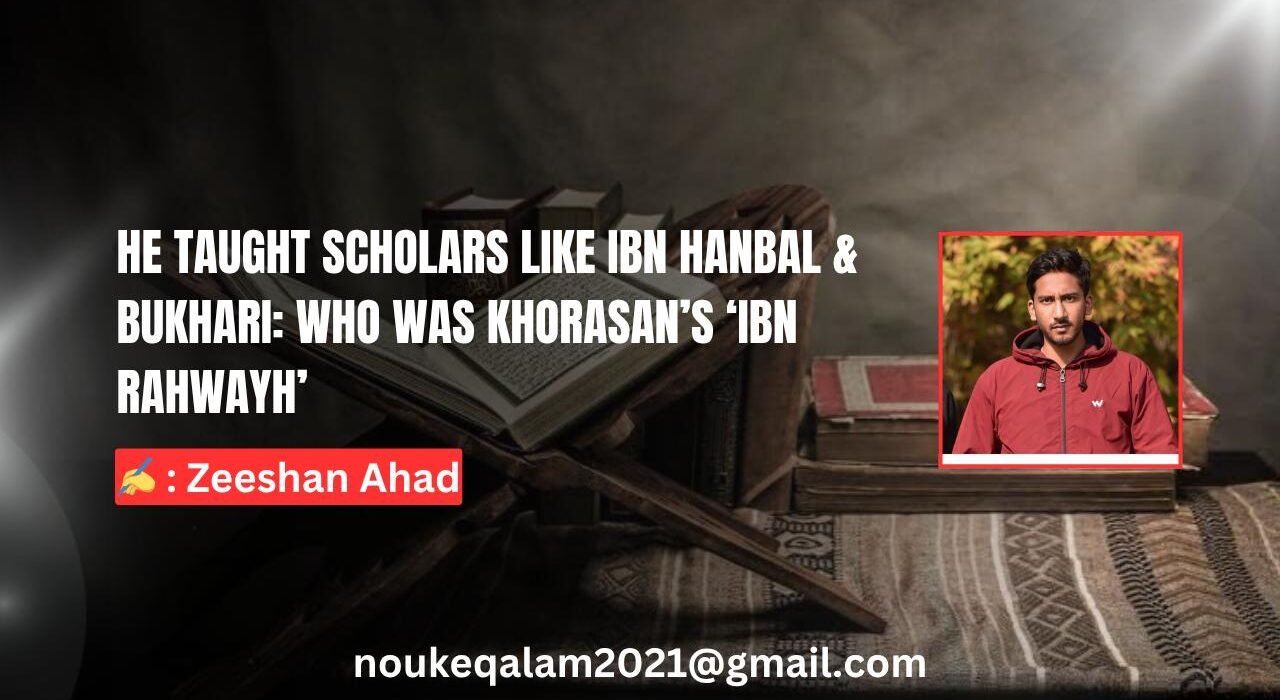✒️:. Zeeshan Ahad
In the earlier academic period of Islam, where scholars travelled deserts in search of sacred knowledge, one name stood out—Ishaq ibn Rahwayh. His life was marked by an unshakable devotion to preserving the words of the Prophet (PBUH)
Abu Yaqoob Ishaq Ibn Ibrahim, was born in 166 Hijri of the Islamic Calendar in the region of Marw-Khorasan, a historical region in Central Asia. His lineage traces back to the noble tribe of Tamim, (‘Tamim’ is also spelled as ‘Banu-Tamim’, it considered as a significant Arab tribe originated from Najd, a historical region of Arabian Peninsula).
Among the masses he was famously known as ‘Ibn Rahwayh’ (meaning a son whose father was born on the road) a name tied to an unusual family event. His father (Ibrahim) had been born on the road to Makkah (“Rah” meaning path), earning him the nickname Rahwayh.
Though his father disliked it, the young Ishaq embraced it, as if the vision his own journey—one that would take him across the Muslim world.
Even his birth carried a sign. His son ‘Ali ibn Ishaq’ later recalled that his farther Ishaq ibn Rahwayh was born with pierced ears—a detail that led a scholar, ’Fadl ibn Musa’, to predict: “This child will become a leader—either in good or evil.”
Later history proved it true, for he became ‘Amir al-Momineen Fil-Hadith’—a title reserved for the most trusted guardians of prophetic tradition.
At 23, the buddying Ishaq left for Iraq, sitting at the feet of great teachers, absorbing the sayings of the Prophet Mohammad (PBUH) from the generation after the Companions.
Even after many years his thirst for the Knowledge of Hadith didn’t stop there—he travelled to various Arab Countries like Hijaz, Yemen, and Syria, learning from the finest minds of his time. By the time he settled in Nishapur, a city located in Iran his name had become synonymous with integrity and depth in hadith.
His life was also nourished in an era when Islam was flourished under the Caliphate of Abbasids. Eight Caliphs ruled during his lifetime, including the legendary Harun al-Rashid.
Around him, top Scholars and Jurist’s like Ahmad ibn Hanbal, Mohammad bin Ismail al-Bukhari, and Mohammad Bin Idrees Al- Shafi’i were shaping Islamic literature.
It was a time when hadith were being scrutinized, compiled, and preserved—laying the foundation of books like Musnad Ahmad, Sahih Bukhari and Sahih Muslim.
Yet, Ishaq being their contemporary- wasn’t restricted only to learning. However, a time arose when Ishaq ibn Rahwayh, mastered the science of Hadith. His efforts were brought into light when he stood-up as a teacher around those who used to be his mates in learning.
Even the top Hadith Scholars like Ahmad Bin Hanbal and Mohammad Al-Bukhari used to visit him for lectures.
Many of the Scholars have quoted a collective respect for his teaching virtuous:
Ahmad ibn Hanbal, said: “Why even ask about Ishaq? To us, he was an Imam. I’ve seen no one like him.”
Yahya ibn Yahya confessed: “A single day with him was worth more than a lifetime.”
Mohammad Bin Ismail Al-Bukhari, said “Besides schooling me the science of Hadith, Ishaq was the man who instructed me to compile ‘Sahih Al-Bukhari’
Even Qutaybah ibn Sa‘eed placed him among Khurasan’s top three hadith scholars, alongside Abdullah al-Darimi and Imam Bukhari.
Till his old-age, he extensively collected Hadith and also Commentary of the Holy Quran. But time has been unkind with him. His complete Musnad has been lost over time. Only the 34th section of the fourth volume remains, preserved in Al-Zahiriyah Library at Damascus, Syria.
Ishaq ibn Rahwayh, lived around 75 years and left this world in 238 Hijri at Nishapur, Khurasan. His death, too, carried a touch of the extraordinary.
Ibn Salmah al-Karahisi, who is Ishaq’s student said: “The night when Ishaq Ibn Rahwayh, passed away, I saw the moon rose towards the sky from the street where Ishaq lived. Then it descended at a particular place.
He further narrates, He had no knowledge of Ishaq’s death at that time. But in the morning, he recognized the very spot clearly; where the moon descended at last night and this was the place where Ishaq Ibn Rahwayh’s, grave was made”.
Thus, so far, his influence lives in the students he taught—Bukhari, Muslim, Abu Dawud and Ibn Hanbal —who carried his aim into their own monumental works.
May we be inspired by his journey—one marked not by fame, but by an unwavering commitment to preserving the light of Islam.
(This profile is subject to source: Tareekh-E-Baghdad, Tareekh Ibn Asakar, Tabqaat-E-Shafiya, Tareekh Ibn Khalkan, Al-Tahzeeb, Siyar Aa’laame Nubula, Tareekh-E-Kabeer, Al-Intiqa Abdul-Barr, Tazkira-E-Hufaaz etc)




